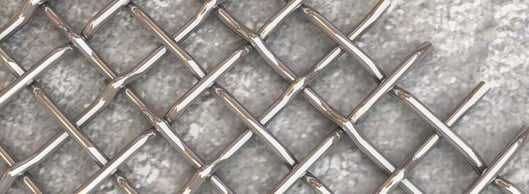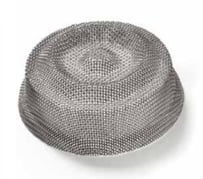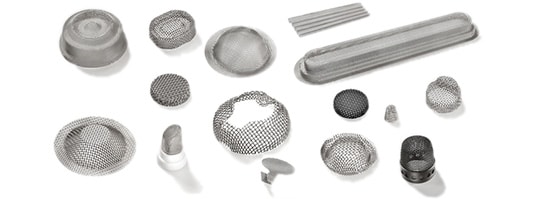How Woven Wire Mesh Funnel Screens Affect Low-Pressure Die Casting
From automobile parts to furniture, the impact of low-pressure casting is all around. To ensure efficient operation and high-quality products, engineers must use adequate funnel screens to remedy some of the common issues that are present when working with molten alloys.
Elements like wire profile and material are vital when implementing these screens. That said, how does stainless steel woven wire mesh affect low-pressure die casting?
W.S. Tyler has worked with wire mesh for over 140 years and has the know-how needed to determine when stainless steel mesh should and should not be used.
With that, this article will establish what woven wire mesh is, what low-pressure die casting is, the benefits and drawbacks of using woven wire mesh, as well as the cost of customized mesh solutions.
What Is Woven Wire Mesh?
Woven wire mesh is a series of individual wires that get interlocked together using a centuries-old weaving technique. Once woven, these wires form accurate square openings that benefit hundreds of applications.

When performing low-pressure casting, wire mesh is implemented in the form of funnel screens. A funnel screen is a deep drawn wire mesh solution that is designed to provide a larger filter area than a standard filter cloth.
In other words, the mesh gets constructed using specifications designed to efficiently block specific elements.
That said, wire mesh offers more benefits outside of the world of filtration.
What Is Low-Pressure Die Casting?
Low-pressure die casting, also referred to as LPDC, is the process in which a product die gets filled with a non-ferrous alloy. A furnace is used to create a small amount of pressure, projecting the molten alloy into the die.
By using low-pressure, the molten alloy gets evenly distributed. With that, the system gets pressurized until the alloy returns to a solid-state.
Benefits of Using Woven Wire Mesh For Low-Pressure Casting
To ensure product quality, manufacturers often use wire mesh funnel screens in the casting machines.
Woven wire screens are particularly useful for three beneficial factors. They are filtration, prevention of air inclusions, and flow rate.

Contamination Filtration
At the beginning of the casting process, the alloy starts as raw, solid material. This raw material often has contaminants that can cause faults within the end-product.
Now, wire mesh funnel screens can have mesh openings as fine as 20 µm and are resistant to heat. This makes them an ideal solution for casting filtration.
By filtering out these contaminants during the casting process, product failure is reduced.
Note: Alloys that feature more heat-resistant qualities, such hastelloy and inconel, can be used to construct woven wire mesh funnel screens. However, the heightened level of heat-resistance often drives the price of these alloys.
Air Inclusion
As with most free-flowing material, air pockets sometimes form within the material. If these air pockets make their way into the mold and solidify, the end-product will have weak areas.
This often results in faulty products.
In low-pressure casting, woven wire mesh acts as a diffuser, eliminating these air pockets. This allows for an even distribution of material throughout the entire mold.
Flow Rate
As stated above, the funnel screens used in the low-pressure die casting equipment can be made from various materials. The biggest drawback associated with not using woven wire mesh is that a lot of funnel screens consist of materials with a flat form factor.
The flat profile of these screens increases the amount of surface area that the melt must maneuver around.
Having said that, the round wires used to construct woven wire mesh combats this issue. This is because the use of round wires minimizes the amount of surface area that prevents melt flow.
Drawbacks of Using Woven Wire Mesh For Low-Pressure Casting
Once the molded alloy has solidified, the filter’s housing leaves access material on the mold. This access material gets removed before the end-product gets prepped for shipment.
As woven wire mesh is often constructed out of stainless steel, this access material cannot get reused. This is because the stainless steel would contaminate the molten alloy.
As a result, the access material gets discarded.
This access material can get melted down for future casting when other materials get used to construct the funnel screen.
How Much Do Woven Wire Mesh Funnel Screens Cost?
As not all casting machinery is the same, woven wire funnel screens are often customized. This means the cost varies based on the needs of the customer.
That said, several factors determine the cost. Layer configuration, size, shape, mesh specifications, quantity, and fabrication time all affect the cost of a customized mesh solution.
Explore the Possibilities of Formed Woven Wire Mesh Solutions
Woven wire mesh is often constructed out of stainless steel and formed into funnel screens when used for low-die casting. That said, wire mesh can get customized to accommodate most casting processes.
Woven wire mesh is a series of wires interlocked together during a centuries-old weaving process. It offers contamination filtration, prevention of air inclusions, and adequate flow of material during low-pressure casting.
That said, the use of stainless steel wire screens will prevent the melting down of access material.
With over 140 years of woven wire mesh experience, W.S. Tyler is here to help you enhance your casting process with customized wire mesh solutions. To learn more about formed woven wire mesh screens, review our article: How Are Custom Wire Mesh Components Formed?.
About Ronnie Brown
Ronnie is the Content Writer for W.S. Tyler and has four years of experience as a professional writer. He strives to expand his knowledge on all things particle analysis and woven wire mesh to leverage his exceptional writing and graphic design skills, creating a one-of-a-kind experience for customers.




